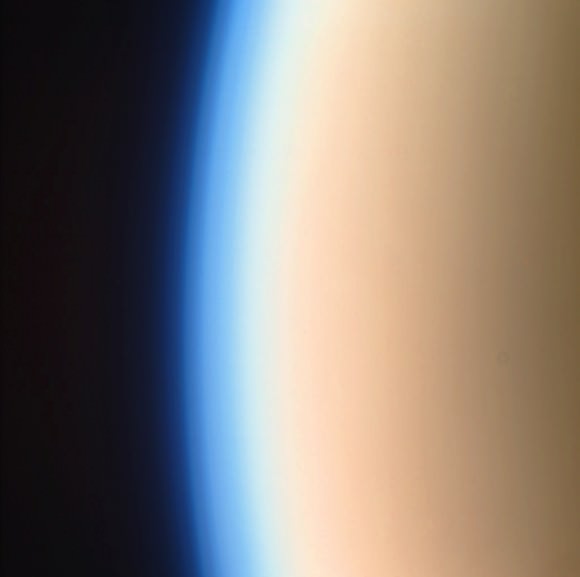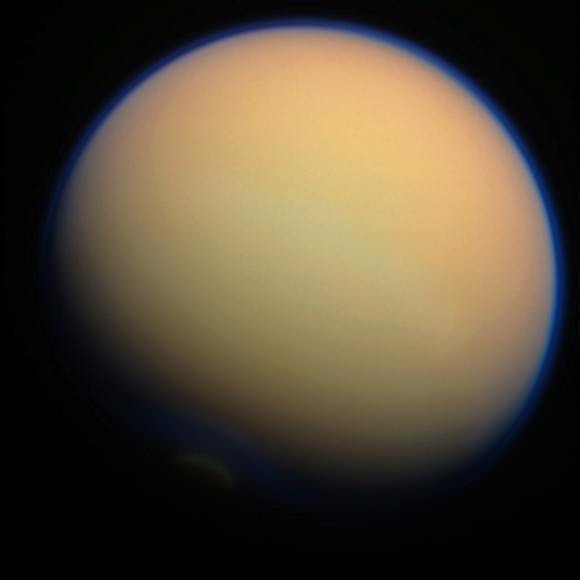On September 26-27 Cassini executed its latest flyby of Titan, T-86, coming within 594 miles (956 km) of the cloud-covered moon in order to measure the effects of the Sun’s energy on its dense atmosphere and determine its variations at different altitudes.
The image above was captured as Cassini approached Titan from its night side, traveling about 13,000 mph (5.9 km/s). It’s a color-composite made from three separate raw images acquired in red, green and blue visible light filters.
Titan’s upper-level hydrocarbon haze is easily visible as a blue-green “shell” above its orange-colored clouds.
Cassini captured this image as it approached Titan’s sunlit limb, grabbing a better view of the upper haze. Some banding can be seen in its highest reaches.
The haze is the result of UV light from the Sun breaking down nitrogen and methane in Titan’s atmosphere, forming hydrocarbons that rise up and collect at altitudes of 300-400 kilometers. The sea-green coloration is a denser photochemical layer that extends upwards from about 200 km altitude.
In this image, made from data acquired on Sept. 27, Titan’s south polar vortex can be made out just within the southern terminator. The vortex is a relatively new feature in Titan’s atmosphere, first spotted earlier this year. It’s thought that it’s a region of open-cell convection forming above the moon’s pole, a result of the approach of winter to Titan’s southern half.
Read: Cassini Spots Surprising Swirls Above Titan’s South Pole
This T-86 flyby was was one of a handful of opportunities to profile Titan’s ionosphere from the outermost edge of Titan’s atmosphere. In addition Cassini was able to look for any changes to Ligeia Mare, a methane lake last observed in spring of 2007.
Now that Titan has been under scrutiny for a full year of Saturn’s seasons — which lasts 29.7 Earth-years — astronomers now know that varying amounts of solar radiation can drastically change situations both within Saturn’s atmosphere and on its surface.
“As with Earth, conditions on Titan change with its seasons. We can see differences in atmospheric temperatures, chemical composition and circulation patterns, especially at the poles,” said Dr. Athena Coustenis from the Paris-Meudon Observatory in France. “For example, hydrocarbon lakes form around the north polar region during winter due to colder temperatures and condensation. Also, a haze layer surrounding Titan at the northern pole is significantly reduced during the equinox because of the atmospheric circulation patterns. This is all very surprising because we didn’t expect to find any such rapid changes, especially in the deeper layers of the atmosphere.”
“It’s amazing to think that the Sun still dominates over other energy sources even as far out as Titan, over 1.5 billion kilometres from us.”
– Dr. Athena Coustenis, Paris-Meudon Observatory
The image above, acquired on Sept. 28, was added to this post on Oct. 1. It was taken from a distance of 649,825 miles (1,045,792 kilometers.)
Cassini’s next targeted approach to Titan — T-87 — will occur on November 13.
Get more news from the Cassini mission here.
Image credits: NASA/JPL/Space Science Institute. All color composites by Jason Major. Images have not been validated or calibrated by the SSI team.
(Do you love the Cassini mission as much as we do? Vote on your favorite Cassini “Shining Moment” here, in honor of the 15th anniversary of Cassini’s launch on October 15! Amazing to think it’s already been 15 years — 8 of those in orbit around Saturn!)





This isn’t suprising in the least, amazing? Not even close.
Very nice images though 🙂
We’re arriving at a point with Cassini where it’s still collecting data and pictures, but it’s got diminishing new results.
I like pretty pictures, but there’s not really anywhere new to photograph, just new pictures.
Seasonal changes are what Cassini’s focusing on now. It’s one thing to buzz a world and snap pics, it’s something else entirely to be able to observe it over a full year — esp when that “year” is 30 of ours long. Recent point in case: Titan’s southern vortex. That’s something we never would have seen had Cassini not stuck around this long.
Wow. What wonderful images.
Can you explain more about your composite process, please?
I use raw images available on the Cassini mission site. When there’s three images included in the red, green and blue filters of the same shot, I can combine them in Photoshop to create a “true color” view. Some tweaking needs to be done still, as the exposure isn’t always right in each channel, but it’s a start. I usually have to edit the blue channel a lot to get Titan’s signature orange cast to show up.
Thanks, Jason!
Great article, Jason i especially like how you capped off the paragraph noting the 15 yer launch anniversary with a video of it launching. Nice touch!
That crescent Moon of ghostly blue-light, its haunting atmospheric halo, suspended above the frigid-mists of gloom, in coldest dark of Saturn’s night, is splendid. Elusive lakes, a strange swirling cloud in the obscuring mists, and, a dimly-lit hanging “haze layer” on the far-side? It all gave me a chill.
– Surely someone slipped in an old, out-dated space-art painting of exotic world imagination, in place of Cassini’s 2nd actual hard-copy photo. The pastel colors are too complimentary, and appealing to be true (even if enhanced)! Banding in the upper atmosphere? Cannot be, my computer screen’s must be flawed.
Beautiful! ____________________
– – – – “It’s amazing to think that the Sun still dominates over other energy sources even as far out as Titan, over 1.5 billion kilometres from us.” – Dr. Athena Coustenis, Paris-Meudon Observatory – – – –
The same ancient Star that lays claim over the distant, cold moon of Titan’s changing apparition, enshrouded in dim-glow of Saturn’s night of perpetual freeze, also, with dynamic power and sustained embrace, holds fast in its radiance our Planet of Life, preserving the plantings of Terra’s seed.